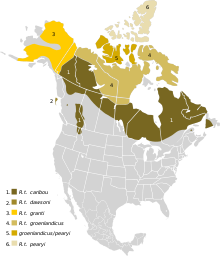Peary caribou
| Peary caribou | |
|---|---|
 |
|
| Peary caribou | |
| Scientific classification | |
| Kingdom: | Animalia |
| Phylum: | Chordata |
| Class: | Mammalia |
| Order: | Artiodactyla |
| Family: | Cervidae |
| Subfamily: | Capreolinae |
| Genus: | Rangifer |
| Species: | R. tarandus |
| Subspecies: | R. t. pearyi |
| Trinomial name | |
|
Rangifer tarandus pearyi Allen, 1902 |
|
 |
|
| Approximate range of Peary caribou. Overlap with other subspecies of caribou is possible for contiguous range. 1. Rangifer tarandus caribou subdivided into ecotypes: woodland (boreal), woodland (migratory), woodland (montane), 2.R. t. Dawsoni extinct 1907, 3. R. t. granti, 4. barren-ground caribou R. t. groenlandicus, 5. Groenlandicus/Pearyi 6. Peary caribou R. t. pearyi | |
The Peary caribou (Rangifer tarandus pearyi) is a caribou subspecies found in the high Arctic islands of Canada's Nunavut and Northwest territories. They are the smallest of the North American caribou, with the females weighing an average of 60 kilograms (130 lb) and the males 110 kilograms (240 lb). In length the females average 1.4 m (4.6 ft) and the males 1.7 m (5.6 ft).
Like other reindeer, both the males and females have antlers. The males grow their antlers from March to August and the females from June to September, and in both cases the velvet is gone by October. The coat of the caribou is white and thick in the winter. In the summer it becomes short and darker, almost slate-grey in colour. The coat is made up of hollow hair which helps to trap warmer air and insulate the caribou.
The males become sexually mature after two years and the females after three years. Breeding is in the fall and depends on the female having built up sufficient fat reserves. The gestation period last for 7 to 8 months and one calf is produced.
Peary caribou feed on most of the available grasses, Cyperaceae (sedges), lichen and mushrooms. In particular they seem to enjoy the purple saxifrage and in summer their muzzles become purple from the plants. Their hooves are sharp and shaped like a shovel to enable them to dig through the snow in search of food.
The caribou rarely travel more than 150 km (93 mi) from their winter feeding grounds to the summer ones. They are able to outrun the Arctic wolf, their main predator, and are good swimmers. They usually travel in small groups of no more than twelve in the summer and four in the winter.
The Peary caribou population has dropped from above 40,000 in 1961 to about 700 in 2009. During this period, the number of days with above freezing temperatures has increased significantly, resulting in ice layers in the snow pack. These ice layers hinder foraging and are the likely cause for dramatic drops in caribou population in the future.
...
Wikipedia
